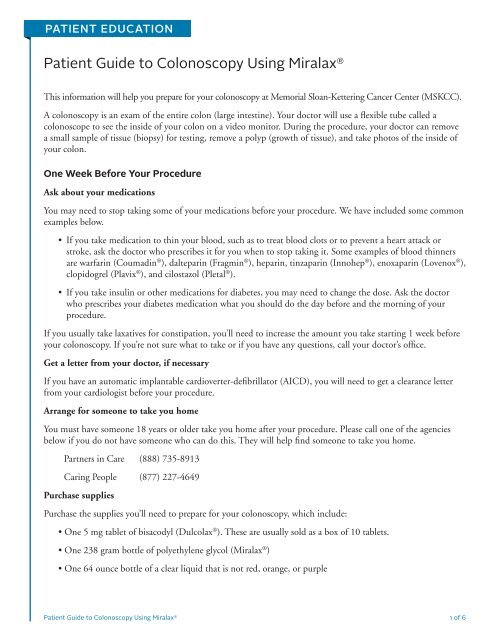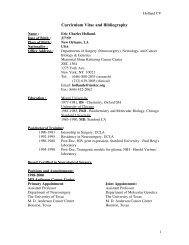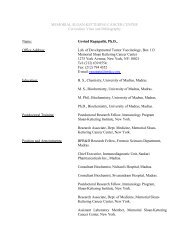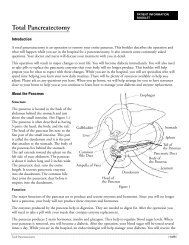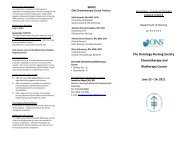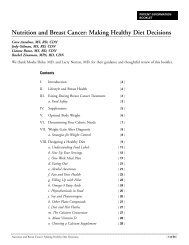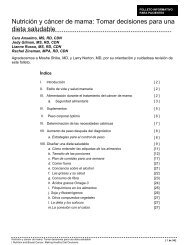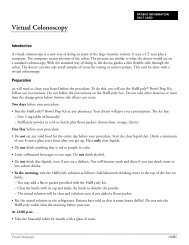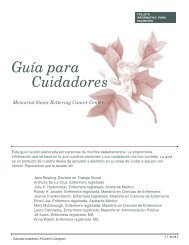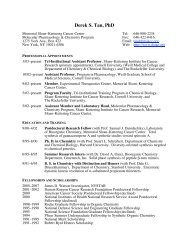Patient Guide to Colonoscopy - Memorial Sloan-Kettering Cancer ...
Patient Guide to Colonoscopy - Memorial Sloan-Kettering Cancer ...
Patient Guide to Colonoscopy - Memorial Sloan-Kettering Cancer ...
Create successful ePaper yourself
Turn your PDF publications into a flip-book with our unique Google optimized e-Paper software.
PATIENT EDUCATION<br />
<strong>Patient</strong> <strong>Guide</strong> <strong>to</strong> <strong>Colonoscopy</strong> Using Miralax ®<br />
This information will help you prepare for your colonoscopy at <strong>Memorial</strong> <strong>Sloan</strong>-<strong>Kettering</strong> <strong>Cancer</strong> Center (MSKCC).<br />
A colonoscopy is an exam of the entire colon (large intestine). Your doc<strong>to</strong>r will use a flexible tube called a<br />
colonoscope <strong>to</strong> see the inside of your colon on a video moni<strong>to</strong>r. During the procedure, your doc<strong>to</strong>r can remove<br />
a small sample of tissue (biopsy) for testing, remove a polyp (growth of tissue), and take pho<strong>to</strong>s of the inside of<br />
your colon.<br />
One Week Before Your Procedure<br />
Ask about your medications<br />
You may need <strong>to</strong> s<strong>to</strong>p taking some of your medications before your procedure. We have included some common<br />
examples below.<br />
• If you take medication <strong>to</strong> thin your blood, such as <strong>to</strong> treat blood clots or <strong>to</strong> prevent a heart attack or<br />
stroke, ask the doc<strong>to</strong>r who prescribes it for you when <strong>to</strong> s<strong>to</strong>p taking it. Some examples of blood thinners<br />
are warfarin (Coumadin ® ), dalteparin (Fragmin ® ), heparin, tinzaparin (Innohep ® ), enoxaparin (Lovenox ® ),<br />
clopidogrel (Plavix ® ), and cilostazol (Pletal ® ).<br />
• If you take insulin or other medications for diabetes, you may need <strong>to</strong> change the dose. Ask the doc<strong>to</strong>r<br />
who prescribes your diabetes medication what you should do the day before and the morning of your<br />
procedure.<br />
If you usually take laxatives for constipation, you’ll need <strong>to</strong> increase the amount you take starting 1 week before<br />
your colonoscopy. If you’re not sure what <strong>to</strong> take or if you have any questions, call your doc<strong>to</strong>r’s office.<br />
Get a letter from your doc<strong>to</strong>r, if necessary<br />
If you have an au<strong>to</strong>matic implantable cardioverter-defibrilla<strong>to</strong>r (AICD), you will need <strong>to</strong> get a clearance letter<br />
from your cardiologist before your procedure.<br />
Arrange for someone <strong>to</strong> take you home<br />
You must have someone 18 years or older take you home after your procedure. Please call one of the agencies<br />
below if you do not have someone who can do this. They will help find someone <strong>to</strong> take you home.<br />
Partners in Care (888) 735-8913<br />
Caring People (877) 227-4649<br />
Purchase supplies<br />
Purchase the supplies you’ll need <strong>to</strong> prepare for your colonoscopy, which include:<br />
• One 5 mg tablet of bisacodyl (Dulcolax ® ). These are usually sold as a box of 10 tablets.<br />
• One 238 gram bottle of polyethylene glycol (Miralax ® )<br />
• One 64 ounce bottle of a clear liquid that is not red, orange, or purple<br />
<strong>Patient</strong> <strong>Guide</strong> <strong>to</strong> <strong>Colonoscopy</strong> Using Miralax ® 1 of 6
Eat a low-residue diet<br />
You must start eating a low-residue diet 7 days before your colonoscopy. A low-residue diet is a diet in which you<br />
eat very few foods that are high in fiber or are hard for your body <strong>to</strong> digest. Fiber is made up of plant material<br />
that can’t be completely digested by your body. Examples of foods high in fiber include whole-grain breads and<br />
cereals, nuts, seeds, and raw or dried fruits. By avoiding these foods before your colonoscopy, you can make sure<br />
your colon will be cleaned out for your procedure.<br />
Grains<br />
Fruits and<br />
Vegetables<br />
Meats and<br />
Protein<br />
Snacks<br />
Drinks<br />
Eat<br />
• White bread<br />
• Plain crackers, such as saltines<br />
• Cooked cereals, such as cream of wheat or grits<br />
• Cold cereals, such as corn flakes or puffed rice<br />
• White rice, noodles, and pasta<br />
• Well-cooked fresh or canned vegetables without seeds,<br />
such as asparagus tips, beets, green beans, carrots,<br />
mushrooms, spinach, squash (no seeds), and pumpkin<br />
• Cooked pota<strong>to</strong>es without skin<br />
• Ripe bananas<br />
• Melon, such as cantaloupe and honeydew<br />
• Canned or cooked fruits without seeds or skin, such as<br />
applesauce or canned pears<br />
• Avocado<br />
• Lean and tender meats, including beef, lamb, chicken,<br />
fish, and pork<br />
• Eggs<br />
• Plain cakes and cookies<br />
• Gelatin, puddings, custard, and sherbet<br />
• Ice cream and popsicles<br />
• Hard candy<br />
• Pretzels<br />
• Vanilla wafers<br />
• Coffee and tea<br />
• Carbonated beverages<br />
• Milk<br />
• Apple juice, no-pulp orange juice, and cranberry juice<br />
• Strained vegetable juices<br />
Avoid<br />
• Seeds, nuts, and coconut<br />
• Whole-grain products, such as pasta,<br />
cereals, crackers, and breads<br />
• Most raw vegetables<br />
• Most raw or dried fruits, such as<br />
pineapple, raisins, and figs<br />
• Certain cooked vegetables, including<br />
peas, broccoli, winter squash, brussel<br />
sprouts, cabbage, corn (and corn<br />
bread), onions, cauliflower, and<br />
pota<strong>to</strong>es with skin<br />
• Beans<br />
• Lentils<br />
• Tofu<br />
• Peanut butter<br />
• Jam, marmalade, and preserves<br />
• Popcorn<br />
• Fruit juices with pulp or seeds<br />
• Prune juice<br />
• Nectars<br />
This is also a good time <strong>to</strong> s<strong>to</strong>ck up on clear liquids <strong>to</strong> drink the day before your procedure.<br />
<strong>Patient</strong> <strong>Guide</strong> <strong>to</strong> <strong>Colonoscopy</strong> Using Miralax ® 2 of 6
3 Days Before Your Procedure<br />
A few days before your procedure, you will receive a telephone call from an endoscopy nurse. He or she will<br />
review the instructions in this guide with you and ask you questions about your medical his<strong>to</strong>ry. The nurse will<br />
also review your medications and tell you which <strong>to</strong> take the morning of your procedure. Use the space below <strong>to</strong><br />
write them down.<br />
Medications you should take the morning of your procedure <br />
The Day Before Your Procedure<br />
Follow a clear liquid diet<br />
You will need <strong>to</strong> follow a clear liquid diet the day before your procedure. Do not drink anything red, purple, or<br />
orange the day before your colonoscopy. Make sure <strong>to</strong> drink plenty of liquids other than water, coffee, and tea.<br />
Drinking enough liquids is an important part of your colonoscopy preparation. Try <strong>to</strong> drink at least one 8-ounce<br />
glass every hour while you’re awake.<br />
Do not drink diet liquids, even if you have diabetes. You will need the calories from the types of liquids listed<br />
below so that you don’t feel faint.<br />
Drink<br />
Avoid<br />
Soups • Clear broth, bouillon, or consommé • Any products with any particles<br />
of dried food or seasoning<br />
Sweets • Gelatin (such as Jello ® )<br />
• Flavored ices<br />
• Sweeteners, such as sugar or honey, may be used<br />
Beverages<br />
• Clear fruit juices, such as white cranberry, white grape, apple<br />
• Soda, such as 7-Up ® , Sprite ® , ginger ale, seltzer, Ga<strong>to</strong>rade ®<br />
• Black coffee (no cream)<br />
• Tea<br />
• Anything red, purple,<br />
or orange<br />
• Juice with pulp<br />
• Nectars<br />
• Milk<br />
• Alcoholic beverages<br />
Prepare your Miralax ® bowel preparation<br />
On the morning before your procedure, mix all 238 grams of Miralax ® with the 64 ounces of clear liquid<br />
until the Miralax ® powder dissolves. Once the Miralax ® is dissolved, you can put the mixture in the refrigera<strong>to</strong>r,<br />
if you prefer.<br />
<strong>Patient</strong> <strong>Guide</strong> <strong>to</strong> <strong>Colonoscopy</strong> Using Miralax ® 3 of 6
Time of your procedure<br />
A clerk from the Admitting Office will call you after 2:00 pm the day<br />
before your procedure. He or she will tell you what time you should<br />
arrive at the hospital for your procedure. If you are scheduled for your<br />
procedure on a Monday, you will be called on the Friday before. If you<br />
do not receive a call, please call (212) 639-7882.<br />
Write in your admission time <br />
Date ________ Time ________<br />
If you need <strong>to</strong> cancel your procedure for any reason please call the doc<strong>to</strong>r who scheduled it for you.<br />
Do not eat or drink anything after midnight the night before your procedure. This includes water,<br />
! gum, and hard candy.<br />
Take your Miralax ® bowel preparation<br />
Emptying out your colon is a very important part of your colonoscopy. If you have s<strong>to</strong>ol in your colon during your<br />
colonoscopy, your doc<strong>to</strong>r may not be able <strong>to</strong> perform the procedure. The Miralax ® bowel preparation will cause<br />
frequent bowel movements, so be sure <strong>to</strong> be near a bathroom the evening before your procedure.<br />
At 3:00 pm on the day before your procedure, take 1 bisacodyl tablet by mouth with a glass of water.<br />
At 5:00 pm on the day before your procedure, start drinking the Miralax ® bowel preparation. Drink an 8<br />
ounce glass of the mixture every 15 minutes until the container is empty. When you’re finished drinking the<br />
Miralax ® bowel preparation, continue <strong>to</strong> drink clear liquids until midnight or until you go <strong>to</strong> bed.<br />
• Apply petroleum jelly (Vaseline ® ) or A & D ® ointment <strong>to</strong> the skin around your anus after every bowel<br />
movement. This helps prevent irritation.<br />
• Drink 4 <strong>to</strong> 6 glasses of clear liquids after you finish the Miralax ® . You may continue <strong>to</strong> drink clear liquids<br />
until midnight, but it is not required.<br />
The Day of Your Procedure<br />
Things <strong>to</strong> remember<br />
• Do not eat or drink anything the morning of your surgery. This includes water, gum, and hard candy.<br />
• Take only the medications you were instructed <strong>to</strong> take the morning of your procedure. You may have<br />
written them down on the first page of this guide. Take them with a few sips of water.<br />
• Do not put on any lotion, cream, powder, make-up, or perfume.<br />
• Remove any jewelry, including body piercings.<br />
• Leave all valuables such as credit cards and jewelry at home.<br />
• If you wear contact lenses, wear your glasses instead.<br />
What <strong>to</strong> bring with you<br />
A list of the medications you take at home<br />
Your rescue inhaler (such as albuterol for asthma), if you have one<br />
A case for your glasses<br />
Your Health Care Proxy form, if you have completed one<br />
<strong>Patient</strong> <strong>Guide</strong> <strong>to</strong> <strong>Colonoscopy</strong> Using Miralax ® 4 of 6
Where <strong>to</strong> park<br />
Parking at <strong>Memorial</strong> <strong>Sloan</strong>-<strong>Kettering</strong> is available in the garage on East 66 th Street between First and York<br />
Avenues. To reach the garage, enter East 66 th Street from York Avenue. The garage is located about ¼ block<br />
<strong>to</strong>ward First Avenue, on the right (north) side of the street. A pedestrian tunnel connects the garage <strong>to</strong> the<br />
hospital. There are also nearby commercial garages: 4 on East 69 th Street between First and Second Avenues and<br />
3 on East 65 th Street between First and Second Avenues. For questions about pricing, call (212) 639-2338.<br />
Where <strong>to</strong> go<br />
Your procedure will take place in the Endoscopy Suite at the main hospital, which is located at 1275 York<br />
Avenue. Take the M eleva<strong>to</strong>r <strong>to</strong> the 2 nd floor.<br />
If you parked in the garage on 66 th Street and York Avenue, follow the signs <strong>to</strong> the A eleva<strong>to</strong>r. Take the A eleva<strong>to</strong>r<br />
<strong>to</strong> the 2 nd floor and enter the Endoscopy Suite through the glass doors.<br />
What <strong>to</strong> expect<br />
Once you arrive at the hospital, doc<strong>to</strong>rs, nurses, and other staff members will ask you <strong>to</strong> state and spell your<br />
name and date of birth many times. This is for your safety. <strong>Patient</strong>s with the same or similar names may be<br />
having procedures on the same day.<br />
After changing in<strong>to</strong> a hospital gown, you will meet your nurse. He or she will place an intravenous (IV) catheter<br />
in<strong>to</strong> a vein, usually in your hand or arm. At first you will receive fluids through the IV, but it will be used later<br />
<strong>to</strong> give you anesthesia (medication <strong>to</strong> make you sleepy). Your doc<strong>to</strong>r will explain the procedure, and answer any<br />
questions you have.<br />
When it’s time for your procedure, you will be brought in<strong>to</strong> the procedure room and helped on<strong>to</strong> an exam table.<br />
You will be attached <strong>to</strong> equipment <strong>to</strong> moni<strong>to</strong>r your heart, breathing, and blood pressure. You will also receive<br />
oxygen through your nose. You will lay on your left side with your knees bent.<br />
You will receive anesthesia through your IV, which will make you fall asleep. Once you are asleep, your<br />
doc<strong>to</strong>r will examine your rectum. Next, a flexible tube called a colonoscope will be put in<strong>to</strong> your rectum. The<br />
colonoscope is connected <strong>to</strong> a video moni<strong>to</strong>r. This allows your doc<strong>to</strong>r <strong>to</strong> see the inside of your colon. Your<br />
doc<strong>to</strong>r will use air and fluid <strong>to</strong> move the colonoscope along the length of your colon while looking for anything<br />
unusual on the video moni<strong>to</strong>r.<br />
After Your Procedure<br />
In the recovery room<br />
You will wake up in the recovery room. Your nurse will continue <strong>to</strong> moni<strong>to</strong>r your heart, breathing, and blood<br />
pressure. Many patients feel bloated and have s<strong>to</strong>mach cramps after a colonoscopy. This is normal and goes away<br />
by passing gas. Once you are fully awake, your nurse will remove your IV. If you have someone waiting with<br />
you, your nurse will explain your discharge instructions <strong>to</strong> both of you before you go home.<br />
At home<br />
• If you have had a biopsy, you may notice a few drops of blood coming from your rectum. This is normal<br />
after a biopsy, however there should be no more than a few drops and it should not last more than<br />
24 hours.<br />
• You may resume your normal activities in 24 hours after your procedure.<br />
<strong>Patient</strong> <strong>Guide</strong> <strong>to</strong> <strong>Colonoscopy</strong> Using Miralax ® 5 of 6
• Do not drink alcoholic beverages for 24 hours after your procedure.<br />
• Begin eating light foods as soon as you are discharged. Work your way up <strong>to</strong> your normal diet. If your<br />
doc<strong>to</strong>r wants you <strong>to</strong> limit your diet for a period of time, he or she will tell you.<br />
Call your doc<strong>to</strong>r or nurse if you have:<br />
• A temperature of 101° F (38.3° C) or higher<br />
• Severe s<strong>to</strong>mach pain or hardness<br />
• Bleeding from your rectum that lasts more than 24 hours<br />
• Bleeding between bowel movements<br />
• Weakness, faintness, or nausea<br />
• Heavy bleeding<br />
Doc<strong>to</strong>r: _____________________________________ Telephone: _________________________________<br />
Nurse: ______________________________________ Telephone: _________________________________<br />
©2013a <strong>Memorial</strong> <strong>Sloan</strong>-<strong>Kettering</strong> <strong>Cancer</strong> Center<br />
1275 York Avenue, New York, New York 10065<br />
B-258<br />
<strong>Patient</strong> <strong>Guide</strong> <strong>to</strong> <strong>Colonoscopy</strong> Using Miralax ® 6 of 6


